Sociology Essay: Alienation, Marx's Theory, and the Rust Belt Analysis
VerifiedAdded on 2022/10/09
|6
|1372
|46
Essay
AI Summary
This essay delves into the concept of alienation as defined by Karl Marx, exploring its theoretical underpinnings and its various forms, including alienation from the product of labor, the process of production, one's species essence, and from others. The essay examines how socioeconomic factors, particularly within a capitalist society, contribute to these forms of alienation. It then applies these theoretical concepts to the historical context of the Rust Belt in the United States, analyzing how the decline of industries in this region exemplifies Marx's theory of alienation. The essay highlights the role of factors like outdated technology, labor costs, and outsourcing in the economic and social disintegration of the Rust Belt, illustrating the real-world consequences of alienation as described by Marx. Furthermore, the essay references the views of other significant thinkers like Hegel and Feuerbach on the concept of alienation.
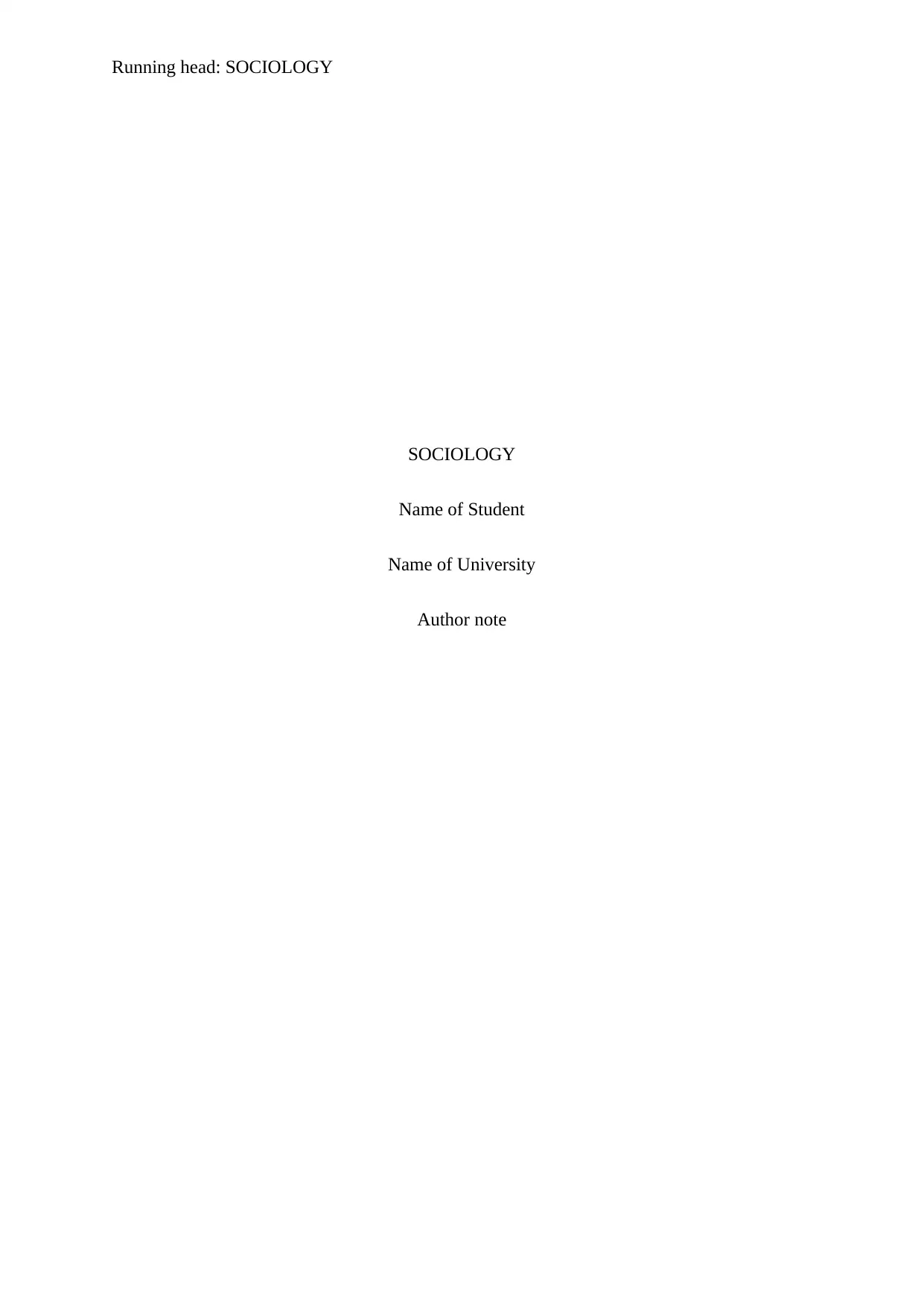
Running head: SOCIOLOGY
SOCIOLOGY
Name of Student
Name of University
Author note
SOCIOLOGY
Name of Student
Name of University
Author note
Paraphrase This Document
Need a fresh take? Get an instant paraphrase of this document with our AI Paraphraser
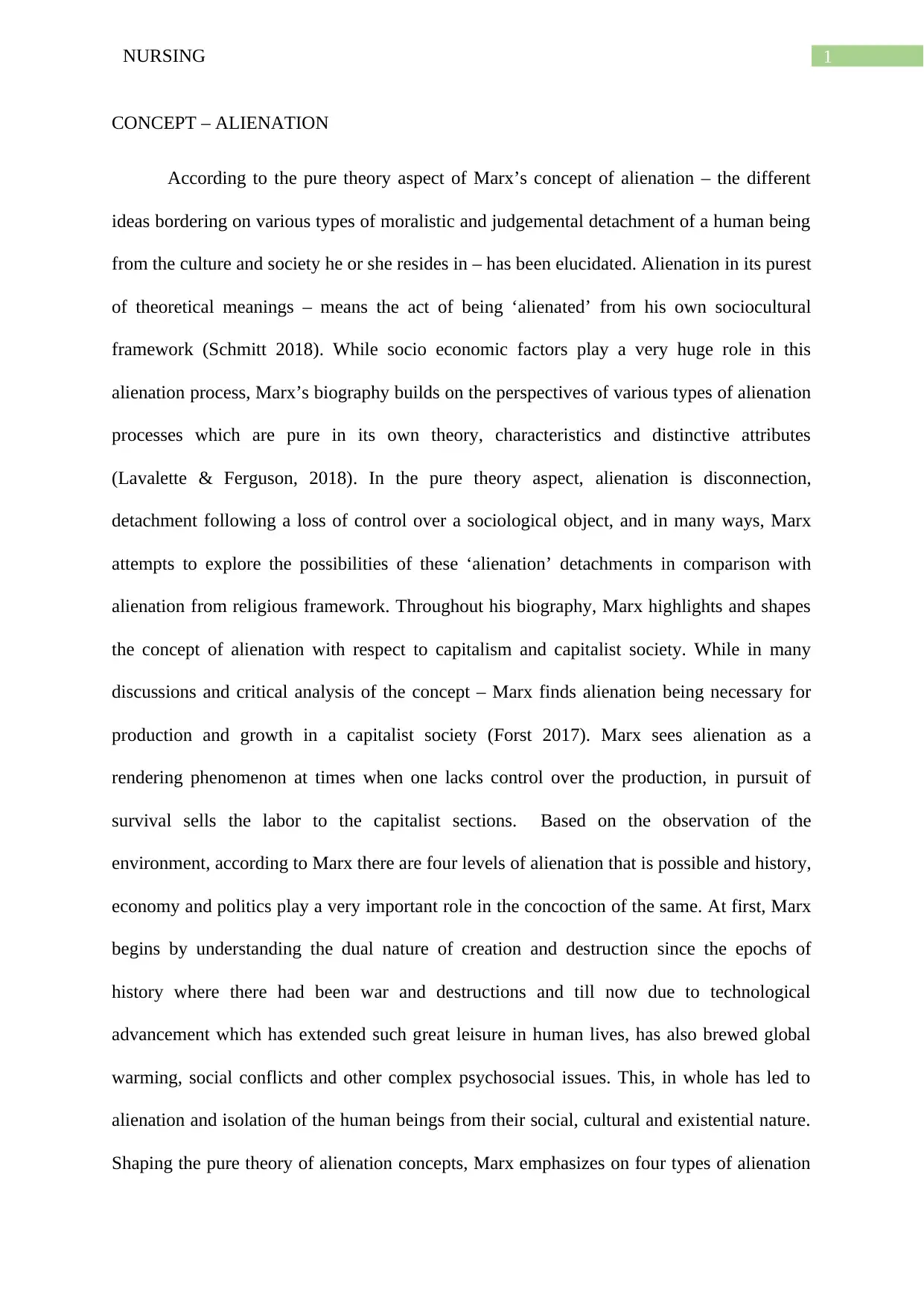
1NURSING
CONCEPT – ALIENATION
According to the pure theory aspect of Marx’s concept of alienation – the different
ideas bordering on various types of moralistic and judgemental detachment of a human being
from the culture and society he or she resides in – has been elucidated. Alienation in its purest
of theoretical meanings – means the act of being ‘alienated’ from his own sociocultural
framework (Schmitt 2018). While socio economic factors play a very huge role in this
alienation process, Marx’s biography builds on the perspectives of various types of alienation
processes which are pure in its own theory, characteristics and distinctive attributes
(Lavalette & Ferguson, 2018). In the pure theory aspect, alienation is disconnection,
detachment following a loss of control over a sociological object, and in many ways, Marx
attempts to explore the possibilities of these ‘alienation’ detachments in comparison with
alienation from religious framework. Throughout his biography, Marx highlights and shapes
the concept of alienation with respect to capitalism and capitalist society. While in many
discussions and critical analysis of the concept – Marx finds alienation being necessary for
production and growth in a capitalist society (Forst 2017). Marx sees alienation as a
rendering phenomenon at times when one lacks control over the production, in pursuit of
survival sells the labor to the capitalist sections. Based on the observation of the
environment, according to Marx there are four levels of alienation that is possible and history,
economy and politics play a very important role in the concoction of the same. At first, Marx
begins by understanding the dual nature of creation and destruction since the epochs of
history where there had been war and destructions and till now due to technological
advancement which has extended such great leisure in human lives, has also brewed global
warming, social conflicts and other complex psychosocial issues. This, in whole has led to
alienation and isolation of the human beings from their social, cultural and existential nature.
Shaping the pure theory of alienation concepts, Marx emphasizes on four types of alienation
CONCEPT – ALIENATION
According to the pure theory aspect of Marx’s concept of alienation – the different
ideas bordering on various types of moralistic and judgemental detachment of a human being
from the culture and society he or she resides in – has been elucidated. Alienation in its purest
of theoretical meanings – means the act of being ‘alienated’ from his own sociocultural
framework (Schmitt 2018). While socio economic factors play a very huge role in this
alienation process, Marx’s biography builds on the perspectives of various types of alienation
processes which are pure in its own theory, characteristics and distinctive attributes
(Lavalette & Ferguson, 2018). In the pure theory aspect, alienation is disconnection,
detachment following a loss of control over a sociological object, and in many ways, Marx
attempts to explore the possibilities of these ‘alienation’ detachments in comparison with
alienation from religious framework. Throughout his biography, Marx highlights and shapes
the concept of alienation with respect to capitalism and capitalist society. While in many
discussions and critical analysis of the concept – Marx finds alienation being necessary for
production and growth in a capitalist society (Forst 2017). Marx sees alienation as a
rendering phenomenon at times when one lacks control over the production, in pursuit of
survival sells the labor to the capitalist sections. Based on the observation of the
environment, according to Marx there are four levels of alienation that is possible and history,
economy and politics play a very important role in the concoction of the same. At first, Marx
begins by understanding the dual nature of creation and destruction since the epochs of
history where there had been war and destructions and till now due to technological
advancement which has extended such great leisure in human lives, has also brewed global
warming, social conflicts and other complex psychosocial issues. This, in whole has led to
alienation and isolation of the human beings from their social, cultural and existential nature.
Shaping the pure theory of alienation concepts, Marx emphasizes on four types of alienation
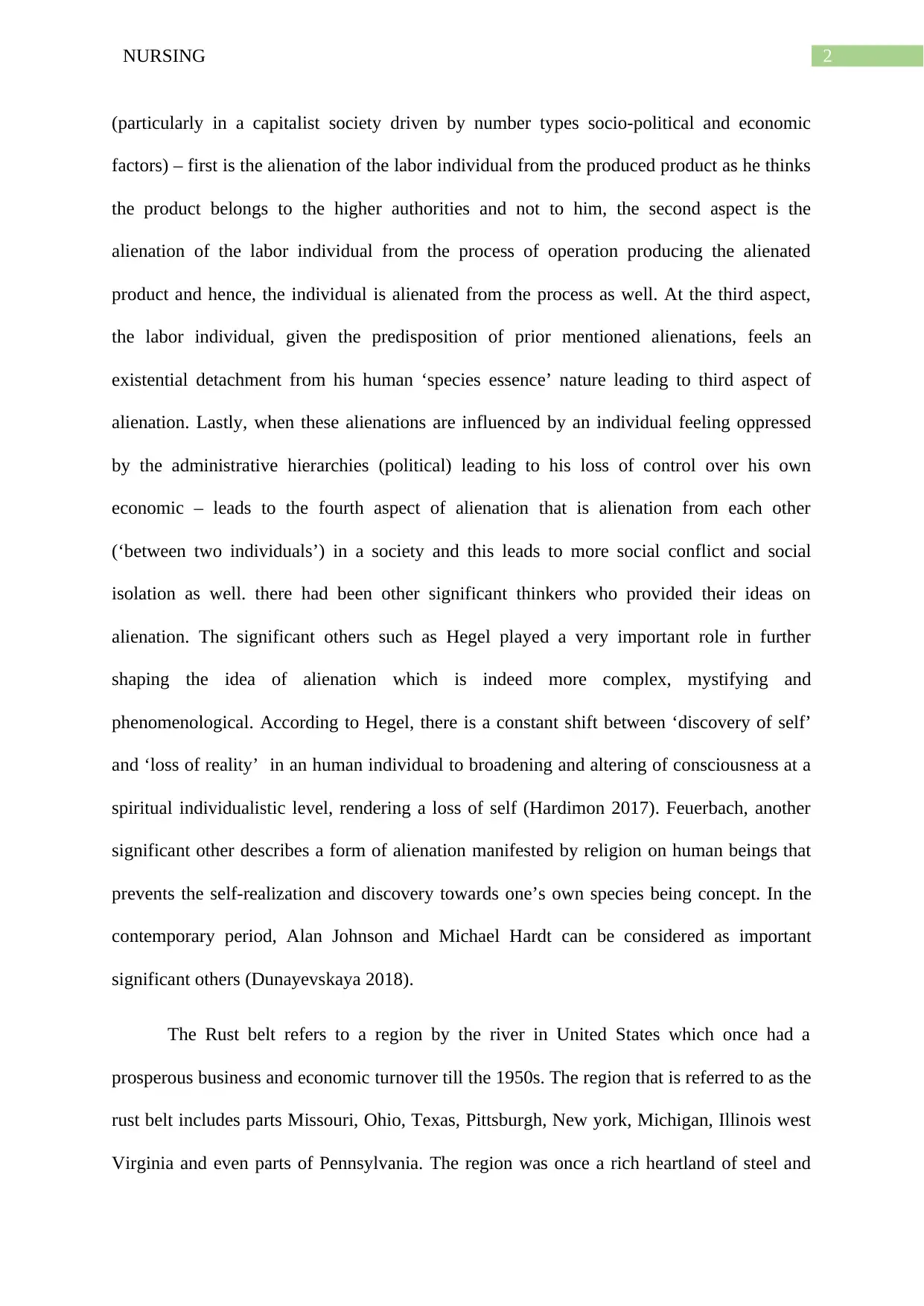
2NURSING
(particularly in a capitalist society driven by number types socio-political and economic
factors) – first is the alienation of the labor individual from the produced product as he thinks
the product belongs to the higher authorities and not to him, the second aspect is the
alienation of the labor individual from the process of operation producing the alienated
product and hence, the individual is alienated from the process as well. At the third aspect,
the labor individual, given the predisposition of prior mentioned alienations, feels an
existential detachment from his human ‘species essence’ nature leading to third aspect of
alienation. Lastly, when these alienations are influenced by an individual feeling oppressed
by the administrative hierarchies (political) leading to his loss of control over his own
economic – leads to the fourth aspect of alienation that is alienation from each other
(‘between two individuals’) in a society and this leads to more social conflict and social
isolation as well. there had been other significant thinkers who provided their ideas on
alienation. The significant others such as Hegel played a very important role in further
shaping the idea of alienation which is indeed more complex, mystifying and
phenomenological. According to Hegel, there is a constant shift between ‘discovery of self’
and ‘loss of reality’ in an human individual to broadening and altering of consciousness at a
spiritual individualistic level, rendering a loss of self (Hardimon 2017). Feuerbach, another
significant other describes a form of alienation manifested by religion on human beings that
prevents the self-realization and discovery towards one’s own species being concept. In the
contemporary period, Alan Johnson and Michael Hardt can be considered as important
significant others (Dunayevskaya 2018).
The Rust belt refers to a region by the river in United States which once had a
prosperous business and economic turnover till the 1950s. The region that is referred to as the
rust belt includes parts Missouri, Ohio, Texas, Pittsburgh, New york, Michigan, Illinois west
Virginia and even parts of Pennsylvania. The region was once a rich heartland of steel and
(particularly in a capitalist society driven by number types socio-political and economic
factors) – first is the alienation of the labor individual from the produced product as he thinks
the product belongs to the higher authorities and not to him, the second aspect is the
alienation of the labor individual from the process of operation producing the alienated
product and hence, the individual is alienated from the process as well. At the third aspect,
the labor individual, given the predisposition of prior mentioned alienations, feels an
existential detachment from his human ‘species essence’ nature leading to third aspect of
alienation. Lastly, when these alienations are influenced by an individual feeling oppressed
by the administrative hierarchies (political) leading to his loss of control over his own
economic – leads to the fourth aspect of alienation that is alienation from each other
(‘between two individuals’) in a society and this leads to more social conflict and social
isolation as well. there had been other significant thinkers who provided their ideas on
alienation. The significant others such as Hegel played a very important role in further
shaping the idea of alienation which is indeed more complex, mystifying and
phenomenological. According to Hegel, there is a constant shift between ‘discovery of self’
and ‘loss of reality’ in an human individual to broadening and altering of consciousness at a
spiritual individualistic level, rendering a loss of self (Hardimon 2017). Feuerbach, another
significant other describes a form of alienation manifested by religion on human beings that
prevents the self-realization and discovery towards one’s own species being concept. In the
contemporary period, Alan Johnson and Michael Hardt can be considered as important
significant others (Dunayevskaya 2018).
The Rust belt refers to a region by the river in United States which once had a
prosperous business and economic turnover till the 1950s. The region that is referred to as the
rust belt includes parts Missouri, Ohio, Texas, Pittsburgh, New york, Michigan, Illinois west
Virginia and even parts of Pennsylvania. The region was once a rich heartland of steel and
⊘ This is a preview!⊘
Do you want full access?
Subscribe today to unlock all pages.

Trusted by 1+ million students worldwide
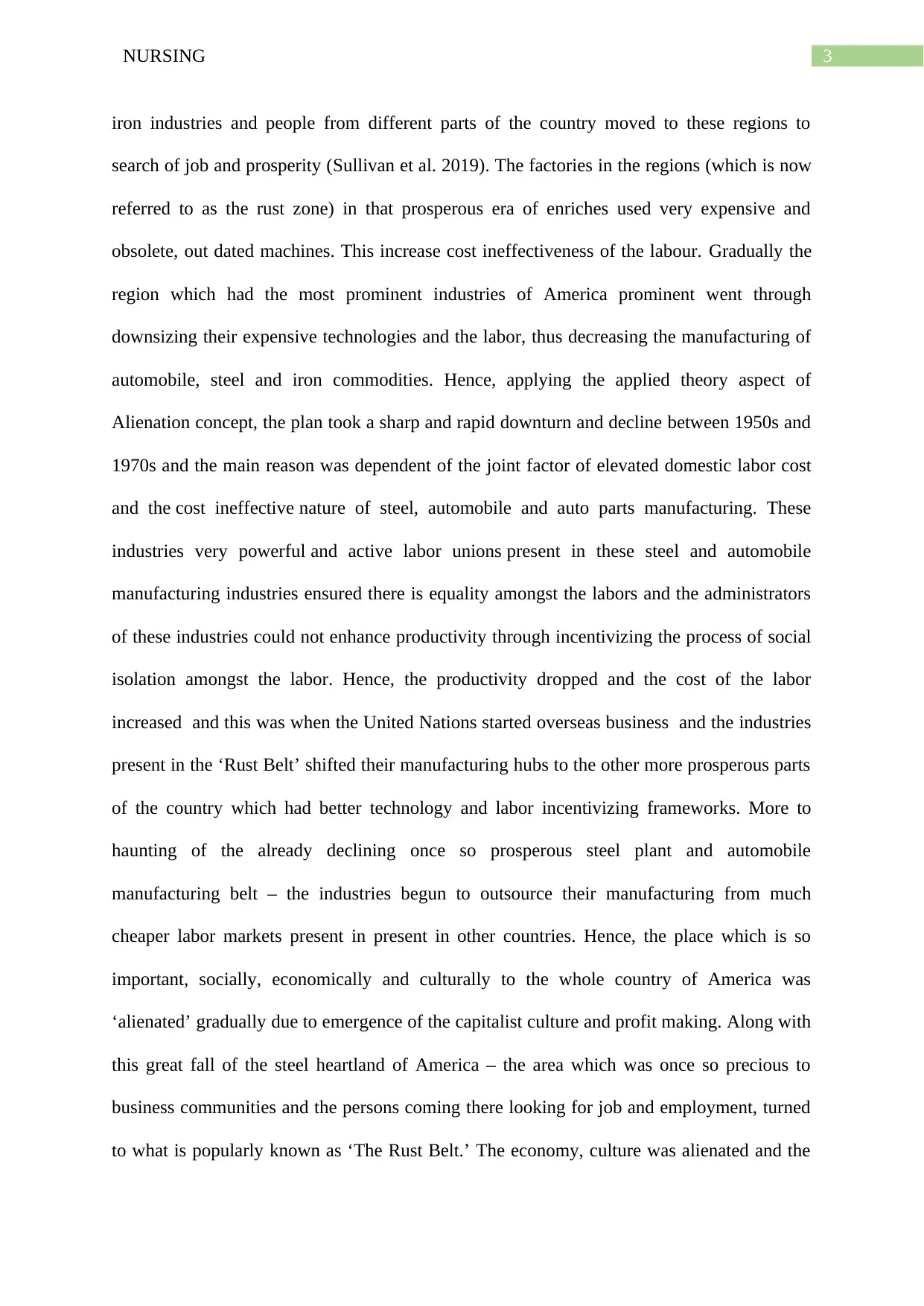
3NURSING
iron industries and people from different parts of the country moved to these regions to
search of job and prosperity (Sullivan et al. 2019). The factories in the regions (which is now
referred to as the rust zone) in that prosperous era of enriches used very expensive and
obsolete, out dated machines. This increase cost ineffectiveness of the labour. Gradually the
region which had the most prominent industries of America prominent went through
downsizing their expensive technologies and the labor, thus decreasing the manufacturing of
automobile, steel and iron commodities. Hence, applying the applied theory aspect of
Alienation concept, the plan took a sharp and rapid downturn and decline between 1950s and
1970s and the main reason was dependent of the joint factor of elevated domestic labor cost
and the cost ineffective nature of steel, automobile and auto parts manufacturing. These
industries very powerful and active labor unions present in these steel and automobile
manufacturing industries ensured there is equality amongst the labors and the administrators
of these industries could not enhance productivity through incentivizing the process of social
isolation amongst the labor. Hence, the productivity dropped and the cost of the labor
increased and this was when the United Nations started overseas business and the industries
present in the ‘Rust Belt’ shifted their manufacturing hubs to the other more prosperous parts
of the country which had better technology and labor incentivizing frameworks. More to
haunting of the already declining once so prosperous steel plant and automobile
manufacturing belt – the industries begun to outsource their manufacturing from much
cheaper labor markets present in present in other countries. Hence, the place which is so
important, socially, economically and culturally to the whole country of America was
‘alienated’ gradually due to emergence of the capitalist culture and profit making. Along with
this great fall of the steel heartland of America – the area which was once so precious to
business communities and the persons coming there looking for job and employment, turned
to what is popularly known as ‘The Rust Belt.’ The economy, culture was alienated and the
iron industries and people from different parts of the country moved to these regions to
search of job and prosperity (Sullivan et al. 2019). The factories in the regions (which is now
referred to as the rust zone) in that prosperous era of enriches used very expensive and
obsolete, out dated machines. This increase cost ineffectiveness of the labour. Gradually the
region which had the most prominent industries of America prominent went through
downsizing their expensive technologies and the labor, thus decreasing the manufacturing of
automobile, steel and iron commodities. Hence, applying the applied theory aspect of
Alienation concept, the plan took a sharp and rapid downturn and decline between 1950s and
1970s and the main reason was dependent of the joint factor of elevated domestic labor cost
and the cost ineffective nature of steel, automobile and auto parts manufacturing. These
industries very powerful and active labor unions present in these steel and automobile
manufacturing industries ensured there is equality amongst the labors and the administrators
of these industries could not enhance productivity through incentivizing the process of social
isolation amongst the labor. Hence, the productivity dropped and the cost of the labor
increased and this was when the United Nations started overseas business and the industries
present in the ‘Rust Belt’ shifted their manufacturing hubs to the other more prosperous parts
of the country which had better technology and labor incentivizing frameworks. More to
haunting of the already declining once so prosperous steel plant and automobile
manufacturing belt – the industries begun to outsource their manufacturing from much
cheaper labor markets present in present in other countries. Hence, the place which is so
important, socially, economically and culturally to the whole country of America was
‘alienated’ gradually due to emergence of the capitalist culture and profit making. Along with
this great fall of the steel heartland of America – the area which was once so precious to
business communities and the persons coming there looking for job and employment, turned
to what is popularly known as ‘The Rust Belt.’ The economy, culture was alienated and the
Paraphrase This Document
Need a fresh take? Get an instant paraphrase of this document with our AI Paraphraser

4NURSING
place was desolated due to third and fourth aspect of aforementioned Marx’s alienation. The
whole place lost its reality, being alienated to its own essence.
place was desolated due to third and fourth aspect of aforementioned Marx’s alienation. The
whole place lost its reality, being alienated to its own essence.
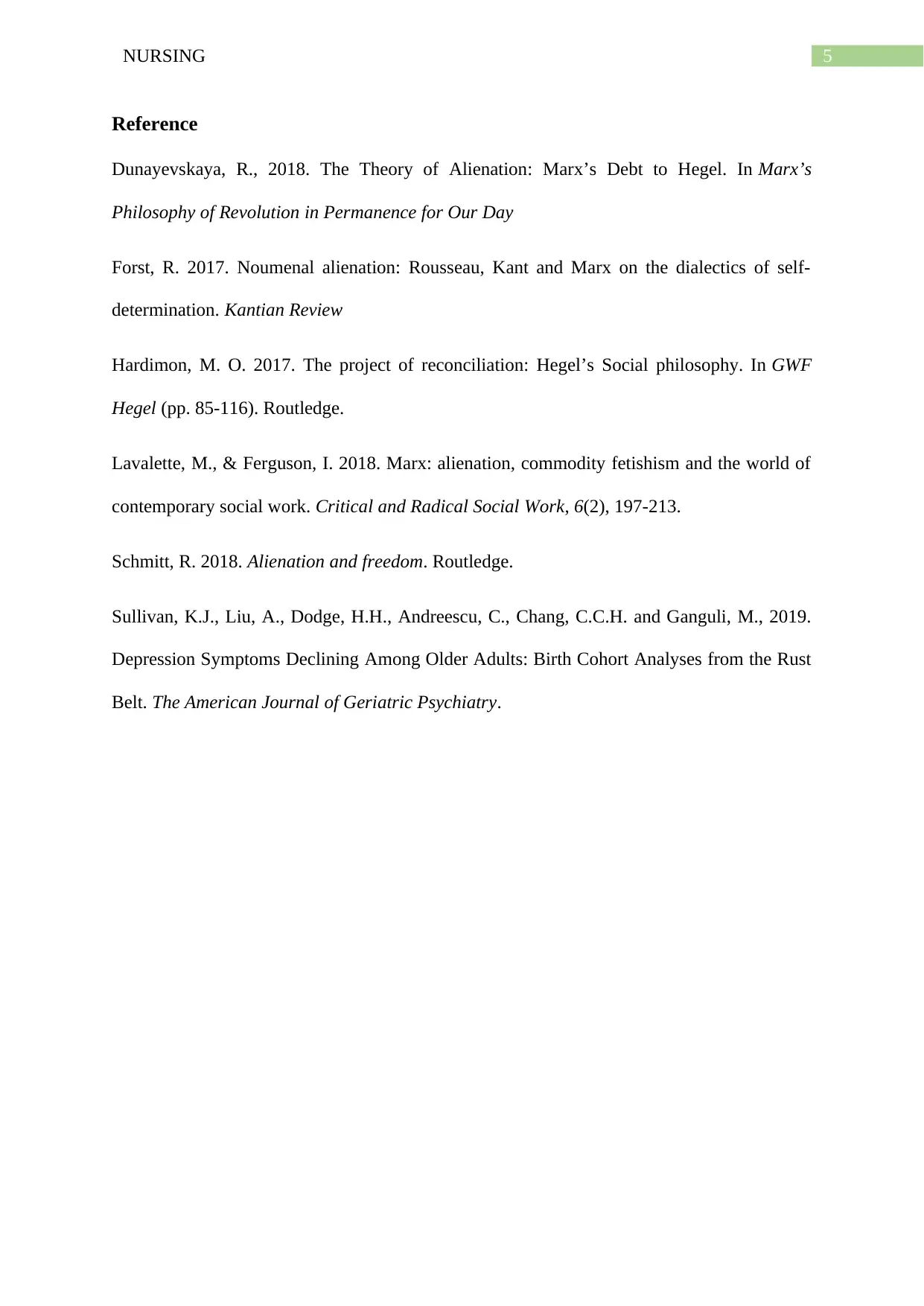
5NURSING
Reference
Dunayevskaya, R., 2018. The Theory of Alienation: Marx’s Debt to Hegel. In Marx’s
Philosophy of Revolution in Permanence for Our Day
Forst, R. 2017. Noumenal alienation: Rousseau, Kant and Marx on the dialectics of self-
determination. Kantian Review
Hardimon, M. O. 2017. The project of reconciliation: Hegel’s Social philosophy. In GWF
Hegel (pp. 85-116). Routledge.
Lavalette, M., & Ferguson, I. 2018. Marx: alienation, commodity fetishism and the world of
contemporary social work. Critical and Radical Social Work, 6(2), 197-213.
Schmitt, R. 2018. Alienation and freedom. Routledge.
Sullivan, K.J., Liu, A., Dodge, H.H., Andreescu, C., Chang, C.C.H. and Ganguli, M., 2019.
Depression Symptoms Declining Among Older Adults: Birth Cohort Analyses from the Rust
Belt. The American Journal of Geriatric Psychiatry.
Reference
Dunayevskaya, R., 2018. The Theory of Alienation: Marx’s Debt to Hegel. In Marx’s
Philosophy of Revolution in Permanence for Our Day
Forst, R. 2017. Noumenal alienation: Rousseau, Kant and Marx on the dialectics of self-
determination. Kantian Review
Hardimon, M. O. 2017. The project of reconciliation: Hegel’s Social philosophy. In GWF
Hegel (pp. 85-116). Routledge.
Lavalette, M., & Ferguson, I. 2018. Marx: alienation, commodity fetishism and the world of
contemporary social work. Critical and Radical Social Work, 6(2), 197-213.
Schmitt, R. 2018. Alienation and freedom. Routledge.
Sullivan, K.J., Liu, A., Dodge, H.H., Andreescu, C., Chang, C.C.H. and Ganguli, M., 2019.
Depression Symptoms Declining Among Older Adults: Birth Cohort Analyses from the Rust
Belt. The American Journal of Geriatric Psychiatry.
⊘ This is a preview!⊘
Do you want full access?
Subscribe today to unlock all pages.

Trusted by 1+ million students worldwide
1 out of 6
Related Documents
Your All-in-One AI-Powered Toolkit for Academic Success.
+13062052269
info@desklib.com
Available 24*7 on WhatsApp / Email
![[object Object]](/_next/static/media/star-bottom.7253800d.svg)
Unlock your academic potential
Copyright © 2020–2025 A2Z Services. All Rights Reserved. Developed and managed by ZUCOL.





